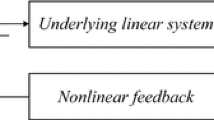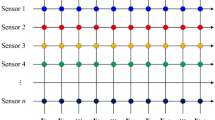Abstract
Nonlinear factors existing in engineering structures have drawn considerable attention, and nonlinear identification is a competent technique to understand the dynamic characteristics of nonlinear structures. Therefore, in this paper, a novel nonlinear separation subspace identification (NSSI) algorithm based on subspace algorithm and nonlinear separation strategy is proposed to conduct nonlinear parameter identification of nonlinear structures. For the proposed NSSI algorithm, the low-level excitation test is firstly conducted to obtain the transfer matrix in the linear response formula. Then, the obtained transfer matrix is used in the high-level excitation test to calculate the nonlinear response part by the proposed nonlinear separation strategy, and the subspace algorithm is utilized to identify the nonlinear parameter on the modified state-space model including only the nonlinear part. The proposed NSSI algorithm can reduce the coupling error caused by simultaneously processing both the large number part (corresponding to the linear part) and small number part (corresponding to the nonlinear part) in the traditional nonlinear subspace identification (NSI) algorithm. At last, two numerical experiments are given to validate the effectiveness of the developed novel nonlinear identification method. Furthermore, some influence factors are discussed to show the stability of the identification algorithm, and some comparisons between the proposed NSSI method and traditional NSI method are also conducted to demonstrate the advantages of the novel method.















Similar content being viewed by others
References
Xie, W., Lee, H., Lim, S.: Nonlinear dynamic analysis of MEMS switches by nonlinear modal analysis. Nonlinear Dyn. 31(3), 243–256 (2003)
Keber, M., Wiercigroch, M.: Dynamics of a vertical riser with weak structural nonlinearity excited by wakes. J. Sound Vib. 315(3), 685–699 (2008)
Yang, Y., Ren, X., Qin, W., Wu, Y., Zhi, X.: Analysis on the nonlinear response of cracked rotor in hover flight. Nonlinear Dyn. 61(1), 183–192 (2010)
Zhang, J., Du, X.: Time-dependent reliability analysis for function generation mechanisms with random joint clearances. Mech. Mach. Theory 92, 184–199 (2015)
Li, P., Chen, W., Li, D., Yu, R., Zhang, W.: Wear analysis of two revolute joints with clearance in multibody systems. J. Comput. Nonlinear Dyn. 11(1), 011009 (2016)
Worden, K., Tomlinson, G.R.: Nonlinearity in Structural Dynamics: Detection, Identification and Modelling. CRC Press, Boca Raton (2000)
Trendafilova, I., Van Brussel, H.: Non-linear dynamics tools for the motion analysis and condition monitoring of robot joints. Mech. Syst. Signal Process. 15(6), 1141–1164 (2001)
Worden, K., Farrar, C.R., Haywood, J., Todd, M.: A review of nonlinear dynamics applications to structural health monitoring. Struct. Control Health Monit. 15(4), 540–567 (2008)
Ibanez, P.: Identification of dynamic parameters of linear and non-linear structural models from experimental data. Nucl. Eng. Des. 25(1), 30–41 (1973)
Masri, S., Caughey, T.: A nonparametric identification technique for nonlinear dynamic problems. J. Appl. Mech. 46(2), 433–447 (1979)
Walter, E., Pronzato, L.: Identification of Parametric Models from Experimental Data. Springer, Berlin (1997)
Nelles, O.: Nonlinear System Identification: From Classical Approaches to Neural Networks and Fuzzy Models. Springer, Berlin (2013)
Feldman, M.: Hilbert transform methods for nonparametric identification of nonlinear time varying vibration systems. Mech. Syst. Signal Process. 47(1), 66–77 (2014)
Liu, J., Li, B., Jin, W., Han, L., Quan, S.: Experiments on clearance identification in cantilever beams reduced from artillery mechanism. Proc. Inst. Mech. Eng. C J. Mech. Eng. Sci. 231(6), 1010–1032 (2017)
Wei, S., Peng, Z., Dong, X., Zhang, W.: A nonlinear subspace-prediction error method for identification of nonlinear vibrating structures. Nonlinear Dyn. 91(3), 1605–1617 (2018)
Kerschen, G., Worden, K., Vakakis, A.F., Golinval, J.: Past, present and future of nonlinear system identification in structural dynamics. Mech. Syst. Signal Process. 20(3), 505–592 (2006)
Noel, J., Kerschen, G.: Nonlinear system identification in structural dynamics: 10 more years of progress. Mech. Syst. Signal Process. 83, 2–35 (2017)
Masri, S., Sassi, H., Caughey, T.: Nonparametric identification of nearly arbitrary nonlinear systems. J. Appl. Mech. 49(3), 619–628 (1982)
Bendat, J.S.: Spectral techniques for nonlinear system analysis and identification. Shock Vib. 1(1), 21–31 (1993)
Richards, C.M., Singh, R.: Identification of multi-degree-of-freedom nonlinear systems under random excitation by the “Reverse Path” spectral method. J. Sound Vib. 213(4), 673–708 (1998)
Adams, D.E., Allemang, R.J.: A frequency domain method for estimating the parameters of a non-linear structural dynamic model through feedback. Mech. Syst. Signal Process. 14(4), 637–656 (2000)
Özer, M.B., Özgüven, H.N.: A new method for localization and identification of non-linearities in structures. In: Proceedings of ESDA 2002: 6th Biennial Conference on Engineering Systems Design and Analysis 2002, pp. 8–11
Arslan, Ö., Aykan, M., Özgüven, H.N.: Parametric identification of structural nonlinearities from measured frequency response data. Mech. Syst. Signal Process. 25(4), 1112–1125 (2011)
Liu, J., Li, B.: Theoretical and experimental identification of clearance nonlinearities for a continuum structure. J. Comput. Nonlinear Dyn. 11(4), 041019 (2016)
Li, B., Han, L., Jin, W., Quan, S.: Theoretical and experimental identification of cantilever beam with clearances using statistical and subspace-based methods. J. Comput. Nonlinear Dyn. 11(3), 031003 (2016)
Marchesiello, S., Garibaldi, L.: A time domain approach for identifying nonlinear vibrating structures by subspace methods. Mech. Syst. Signal Process. 22(1), 81–101 (2008)
Overschee, P.V., Moor, B.D.: Subspace Identification for Linear Systems. Springer, Berlin (1996)
Zhang, M., Wei, S., Peng, Z., Dong, X., Zhang, W.: A two-stage time domain subspace method for identification of nonlinear vibrating structures. Int. J. Mech. Sci. 120, 81–90 (2017)
Noel, J., Marchesiello, S., Kerschen, G.: Subspace-based identification of a nonlinear spacecraft in the time and frequency domains. Mech. Syst. Signal Process. 43(1), 217–236 (2014)
Marchesiello, S., Fasana, A., Garibaldi, L.: Modal contributions and effects of spurious poles in nonlinear subspace identification. Mech. Syst. Signal Process. 74(1), 111–132 (2015)
Filippis, G.D., Noël, J.P., Kerschen, G., Soria, L., Stephan, C.: Model reduction and frequency residuals for a robust estimation of nonlinearities in subspace identification. Mech. Syst. Signal Process. 93(1), 312–331 (2017)
Verhaegen, M.: Identification of the deterministic part of MIMO state space models given in innovations form from input-output data. Automatica 30(1), 61–71 (1994)
Markovsky, I., Huffel, S.V.: Overview of total least-squares methods. Signal Process. 87(10), 2283–2302 (2007)
Adams, D.E., Allemang, R.J.: Characterization of nonlinear vibrating systems using internal feedback and frequency response modulation. J. Vib. Acoust. 121(4), 495–500 (1999)
Ádám, T., Samad, D., József, F.: Influence of discretization method on the digital control system performance. Acta Montan. Slov. 8(4), 197–200 (2003)
Brandt, A.: Noise and Vibration Analysis: Signal Analysis and Experimental Procedures. Wiley, Hoboken (2011)
Acknowledgements
This work is supported financially by the National Natural Science Foundation of China (51475356).
Author information
Authors and Affiliations
Corresponding author
Ethics declarations
Conflict of interest
The authors declare that they have no conflict of interest concerning the publication of this manuscript.
Rights and permissions
About this article
Cite this article
Liu, J., Li, B., Miao, H. et al. A modified time domain subspace method for nonlinear identification based on nonlinear separation strategy. Nonlinear Dyn 94, 2491–2509 (2018). https://doi.org/10.1007/s11071-018-4505-6
Received:
Accepted:
Published:
Issue Date:
DOI: https://doi.org/10.1007/s11071-018-4505-6




